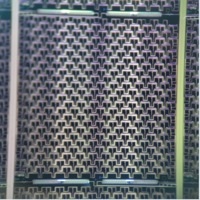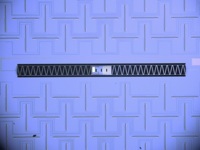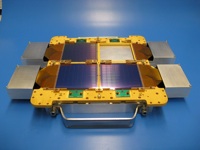
Figure 1 - Antenna

Figure 2 - TES

Figure 3 - Array
|
- System Architecture:
Large format arrays of cryogenic bolometric detectors are the key to Spider's unprecedented sensitivity. Together with a scan strategy that provides daily coverage of approximately 10% of the full sky, Spider's raw sensitivity and frequency coverage will result in a rich dataset which is uniquely suited to the search for the imprint of the CGB on the CMB.
For Spider, the gondola is the cryostat. Six single-frequency telescopes, mounted at fixed elevation about the verticle axis of the gondola, provide a twenty degree field of view with degree-scale beams. The cryogenic telescopes, based on a simple refractor design, provide a large field of view and allow for a nearly optimal modulation scheme. A single frequency cryogenic half-wave plate is mounted in front of the primary optic. A tapered 4-K stop apodizes the illumination of the radiating optic, providing exquisite control of the side-lobe structure. The gondola, when launched from the McMurdo Station, Antarctica, spins at a constant rate. Balloon flights from Antarctica in excess of 20 days have become common in recent years. The Spider cryostat, with a hold time of 25 days, is designed to take full advantage of the an Antarctic LDB flight. As a by-product of the fundamental physics, the Spider data set will provide the most sensitive characterization of polarized galactic emission at mm-wavelengths ever attempted. Additionally, it will measure the weak gravitational lensing of the CMB polarization due to the matter distribution along the line of sight.
- Technical Details:
Spider Instrument Summary
|
90 GHz |
145 GHz |
280 GHz |
|---|
| Bandwidth [GHz] | 22 | 36 | 67 |
|---|
| # Detectors | (2x) 288 | (2x) 512 | (2x) 512 |
|---|
| Beam FWHM [arcmin] | 51 | 31 | 17 |
|---|
| NET_cmb [uK √s] | 5 | 4 | 16 |
|---|
- Array Architecture:
Each of Spider's six focal planes consist of an array of compact superconducting antenna arrays whose signals are detected with superconducting bolometric detectors. Each pixel is fed with a diffraction limited "fixed-phase" phased array antenna cut into a superconducting niobium ground plane. [See Figure 1] The signal from each antenna is propagated along a microstrip line which is terminated on a thermally isolated transition edge superconducting bolometer (TES). [See Figure 2] The ohmic dissipation of the incident radiation results in miniscule temperature variations in the superconducting film, resulting in a change in the signal from the TES which is proportional to the variation in optical power. The extraordinary sensitivity of these devices is limited in large part by the intrinsic temporal fluctuations of the Cosmic Microwave Background Radition.
To define the electromagnetic bands, we are developing sub-millimeter superconducting microstrip filters. The filters have sharp band definition and high rejection of out-of-band power.
Spider's large focal plane arrays are coupled via superconducting transmission lines to SQUID multiplexers [See Figure 3]. Both the filters and the antenna components are fabricated at the Microdevices Laboratory at JPL.
|